ASUS U35Jc: Jogging in Place
by Dustin Sklavos on September 30, 2010 3:00 AM ESTThe Slightly Improved Screen
We gripe constantly about modern notebook screens and with good reason: they're generally terrible. Poor screen quality is something we've often picked on ASUS for in particular, and with each new iteration of their notebooks they proceed to not change the panel. Once again we find ourselves with a similar dilemma.
In Jarred's review of the U30Jc, he cited the screen as being pretty middling, yet with the U35Jc we have the exact same panel type and model on hand. It's neither terrible nor exciting: the glossy 1366x768 panel gets the job done, but it could do the job better.
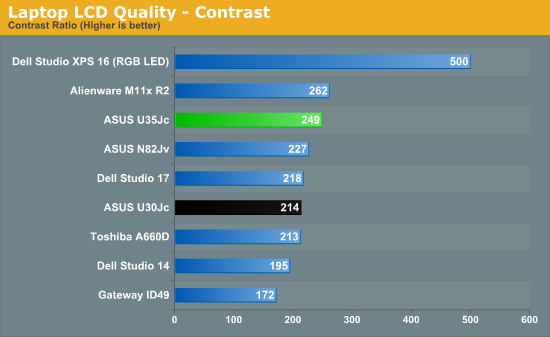
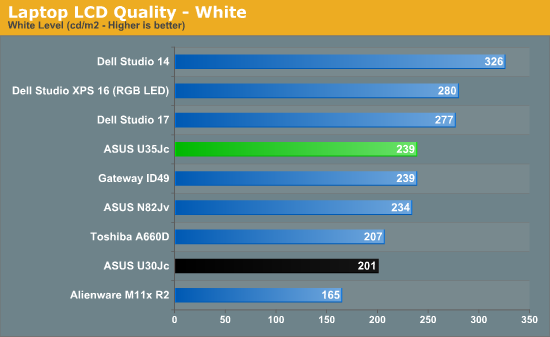
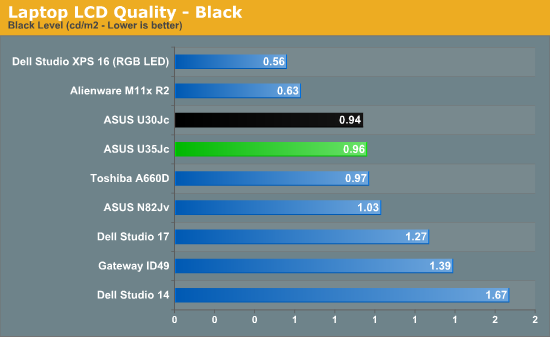
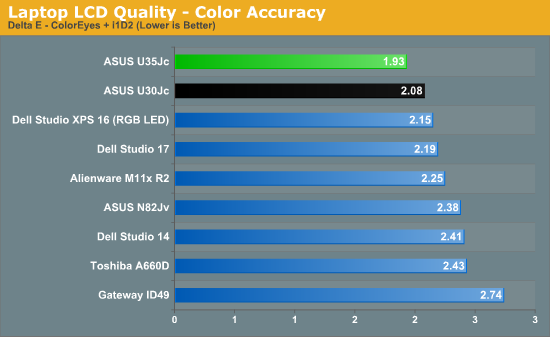
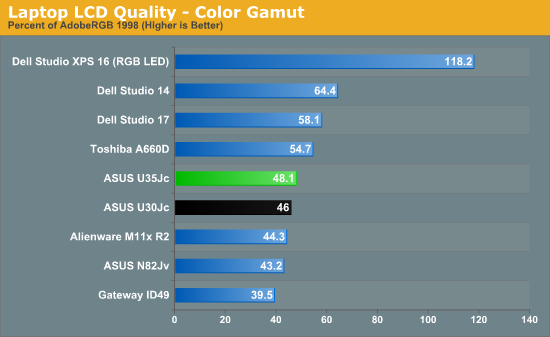
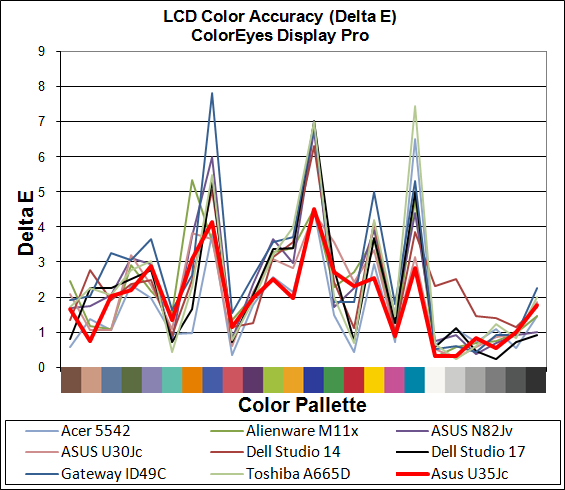

Whatever ASUS changed behind the scenes, at least it improved the quality of this otherwise stunningly mediocre panel somewhat. (The same applies to the U33Jc LCD, incidentally, though delta E wasn't quite so low.) The backlighting of the U35Jc appears to be a bit stronger, allowing the panel to boast a substantially higher—but still not that great—contrast ratio. What's more impressive to us is that several of the spikes we routinely see on all TN laptop panels are noticeably lower. Perhaps it's just the normal variance in inexpensive panels from the LCD manufacturers, but our test U35Jc panel is clearly better than the U30Jc we looked at.
What do we do with this information, though? We've been asking ASUS to use better quality screens for a while now, and in the U35Jc they use the same old screen but at least improve the backlighting and colors a bit. Should we be happy with baby steps? On a 13.3" screen, the 1366x768 resolution is reasonable at least, so we can't cite that as an issue. But the vertical viewing angles shown above are still poor, and color gamut (but not accuracy) appears to be way behind the panels that Dell is using. The U35Jc's screen winds up being a wash (so to speak.)















45 Comments
View All Comments
Dustin Sklavos - Thursday, September 30, 2010 - link
I have to disagree with you. The layout on this notebook has been a standard for a long time now, and it's something I'm very comfortable with and know a few people who feel the same way. I'm a pretty good touch typist and have never had any of the problems you cite, though that's admittedly anecdotal.ran100 - Thursday, September 30, 2010 - link
Now, when nvidia has already announced DX 11.0 series mobile graphics card with optimus technology. It is pity that manufacturers are yet to update. I want a notebook with gtx 460m and optimus. The panel of good quality is certainly important.JarredWalton - Thursday, September 30, 2010 - link
This laptop design was finished and being built probably 3-4 months ago at least, so it's no surprise that they didn't go to 400M. Still, 310M was such a slow card that I really hope it disappears quickly....tno - Thursday, September 30, 2010 - link
I mean this thing is less interesting as far as I'm concerned than a MacBook speed bump. I think sending this one back to Asus and demanding they try again when they have something interesting to review would have been warranted. These should have been released side by side as the U30optical and the U30lite.Jeffk464 - Thursday, September 30, 2010 - link
Nope, nope, nope, must wait for the sangdybridge based version with a 15" monitor. Or maybe a AMD zacate 13" version.zhill - Thursday, September 30, 2010 - link
First, your laptop reviews are the best around as far as I'm concerned, but I have one minor gripe: the choice of comparison machines in the performance/battery tests is somewhat confusing to me. For instance, why not include the protege r700 and the asus u33jc in the graphs as those a contenders for anyone interested in a 13" portable? I understand that you want to throw in an i5, i7um etc and one or two machines from different segements, but it gets old having to look back through old reviews to get the numbers for comparisons. Maybe a Bench addition (like CPU/SSD/GPU Bench) so we can pick our own comparisons to see the data? That would be great.On a positive note, your battery life/wH is a great metric for efficiency and levels the playing field when considering what a higher-capacity upgrade battery might do. Keep up the good work!
JarredWalton - Thursday, September 30, 2010 - link
I'd be interested in hearing your input as to what's "ideal" in terms of charts. I personally think around 8~10 systems is good, as otherwise it gets too cluttered. Dustin I think prefers closer to 6 systems. So, if anyone else has an opinion here let us know! We can obviously put a bunch of the other systems we've reviewed into the charts, but at some point we pass the useful stage and move into information overload.As for Mobile Bench, we've talked about it. I guess I just need to chat with Anand some more and see how soon we can make it happen. :-)
zhill - Thursday, September 30, 2010 - link
First, thanks for the quick response.As for the "ideal" chart presentation, I think that the number of systems you present is just about right--8 systems is perfectly reasonable. However, unless a particular unit performs way above or below its "weight-class" (in the sporting sense) or has some really new/interesting hardware (i.e. the first example of a new CPU/generation), I'm really only interested in similar products, not, for instance, the Studio 17 vs U30JC. However, if a model is particularly bad or really good (rare these days with very similar hardware configs) then some out-of-class comparisons are useful. It's not an easy thing to determine, which is why an interactive system would be perfect as an option. So for the u35jc a nice comparison set might be: r700, u30jc, u33jc, m11x, studio 14, macbook pro-13, and maybe throw in the vaio Z to see what 2X cost gets you. Obviously, these are my personal preferences and relate to how and why I read a review.
Again, great reviews overall. You guys are the only ones who cover the LCDs and keyboards well. I've read far too many other review with "keyboard was good" simply because it's full sized, but in practice the thing is full of mush and terrible. These reviews are particularly great for models that aren't readily available in stores to try out.
vol7ron - Thursday, September 30, 2010 - link
"...a disappointment when 7200 RPM drives have gotten so much cheaper. Power consumption differences between 5400 RPM and 7200 RPM drives can be fairly negligible at this point, so there's really no excuse for going with the faster hardware."Should it be "no excuse for going with the [slower] hardware", or "...for [not] going with the faster hardware"?
JarredWalton - Thursday, September 30, 2010 - link
Fixed.